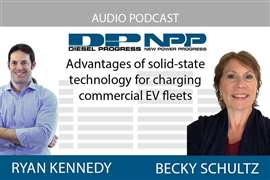Relief ahead for electric vehicle charging pain points
08 December 2023
Rapid growth in commercial EV fleets will require creative charging solutions
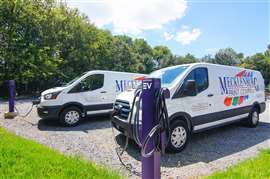 Charging system suppliers are developing technology designed to provide scalability, reliability and efficient energy management. (Photo: Atom Power)
Charging system suppliers are developing technology designed to provide scalability, reliability and efficient energy management. (Photo: Atom Power)
The drive to electrify commercial vehicle fleets is intensifying globally. Mordor Intelligence estimates the market size for commercial electric vehicles (EVs) to have already reached US$105.66 billion globally and expects it to more than triple in scope to $323.73 billion by 2028.
In the U.S., the Environmental Protection Agency projects government incentives and proposed emissions rules to result in the electrification of up to 50% of new vocational vehicles; 35% of new short-haul freight tractor trucks; and 25% of new long-haul freight trucks by 2032.
Such forecasts place added pressure on both utilities and private industry to deliver the charging capacity and options needed to meet this rapidly expanding fleet demand. Even with government rules and incentives, there is a risk of derailing the commercial EV market if charging infrastructure and capacity needs can’t be met.
Infrastructure lags adoption
“The electric vehicle is just as new as charging, but there’s more of a confidence in the reliability of [EVs] than there is the infrastructure to support them, at least as far as we’ve seen across fleets,” said Ryan Kennedy, CEO of Atom Power, a supplier of Level 2 charging systems.
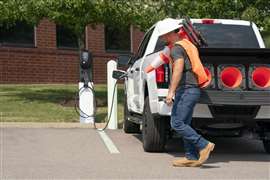 Companies are adding EV chargers where they have the electrical power “headroom,” but lack of infrastructure makes that headroom limited. (Photo: Eaton)
Companies are adding EV chargers where they have the electrical power “headroom,” but lack of infrastructure makes that headroom limited. (Photo: Eaton)
A report issued earlier this year by McKinsey & Co. reflects this. It showed that of the more than 50% of companies surveyed that plan to decarbonize their fleets by 2027, the same number saw infrastructure investment, along with vehicle costs, as significant obstacles to EV adoption.
“We’re past the point of companies electrifying only as much as they have electrical capacity to support. We’ve seen companies looking at their current inventory of buildings and available power and adding in chargers where they have the electrical power headroom,” said Joe Cappeta, director, technical applications – energy transition, Eaton.
Yet, such “headroom” is limited. “We’re already seeing the lack of infrastructure become a real issue, especially for medium- and heavy-duty fleets, which require an enormous amount of power to charge,” Cappeta said. “For this use case, there is no ‘low hanging fruit.’ You really need to start moving electric power across infrastructure and increasing local utility capacity, which requires time to plan and procure.
“Every charger requires infrastructure to make it work, and the more power you need, the more you need to plan ahead.”
The reliability of charging infrastructure is also a concern. “[A fleet’s] financial livelihood depends on the reliability of the vehicles, the reliability of the drivers and the reliability of the gas station to supply them. In this case, when fleets are electrifying, they become largely the ‘gas station,’ because it makes the most sense to charge [EVs] at depots and at their headquarters,” said Kennedy.
Charging availability has been inconsistent, however. “If you look at the data right now, there’s roughly a 70% to 73% uptime across charging stations in the U.S. That’s really low,” Kennedy said. “If 25% of the time they don’t work, it’s not good.
“The reliability of a system is becoming super critical to fleets. To not be able to demonstrate that would limit the adoption of [electric vehicles].”
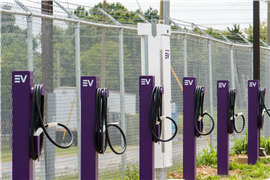 Atom Power’s charging solution utilizes solid-state breakers housed separately from the charging pedestals, which serve solely as a conduit to deliver energy to the vehicles. (Photo: Atom Power)
Atom Power’s charging solution utilizes solid-state breakers housed separately from the charging pedestals, which serve solely as a conduit to deliver energy to the vehicles. (Photo: Atom Power)
A solid (state) alternative
To address these and other fleet pain points, Kennedy believes fleet-level charging needs to be addressed at scale rather than on a singular level.
“Charging vehicles pulls more energy per unit than most things. It can pull up to 19 kW with a single charger,” he commented. “It’s a lot of power, especially if you aggregate that out across a large installation. Oftentimes, that installation can exceed the connected capacity of the utility that they have available... or the infrastructure within the building.”
Energy management is essential. “Energy management is certainly one of the top priorities for problems to solve, and particularly in the fleet sector, because they have a lot more vehicles in a single location than other industries do,” said Kennedy.
To aid fleets in their migration to electrification, Atom Power has developed a platform based on solid-state breakers. Rather than building the charging system into individual pedestals, solid-state breakers are housed within the electrical panels within the main structure. The pedestals serve as a conduit rather than a charger.
“From a traditional Level 2, all the charging function – meaning the software, controls, the hardware – everything’s built into the charger itself that sits out in front of the vehicle. We’re doing it from a breaker that sits away from the vehicle,” Kennedy said. This means less risk of damage to key components as well as easier maintenance.
“For us, it was critical to demonstrate in the fleet market the reliability of the infrastructure. In that sense, it means it doesn’t break as much or the maintenance is super easy – downtime is super low,” he said. “We achieve a 99% uptime.”
Large-scale energy management of an entire site or campus is easier, as well. “With other systems, [they’re] disaggregated… How do you guarantee you’re not going to overload the system? It’s hard if they’re not connected,” Kennedy stated. “But with us, [they’re] by default interconnected and they operate as a sort of singular being across an infrastructure.”
Atom Power’s “infrastructure-focused software” intelligently allocates charging across that infrastructure to avoid overloading the building or utility’s peak load profile. Fleet managers can use it to monitor functions and access metrics related to charger uptime, priority load shedding, peak demand cycles, safety critical functions, ESG objectives, etc. It also maintains cybersecurity of the entire system.
“As fleets become the ‘gas station’, your source of livelihood or success in delivering [goods] or making service calls depends on your fleet being up,” Kennedy stated. “The maintenance side is one thing, the cybersecurity is the other one… Cybersecurity is becoming much more of a concern, especially as the infrastructure gets larger based on the adoption rate.
“We’ve spent a lot of time on ensuring we have what we consider one of the most secure software systems out there,” he added.
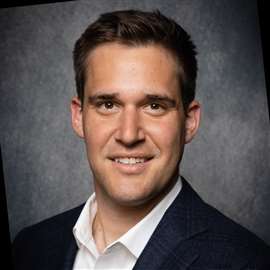 Joe Cappeta, director, technical applications – energy transition, Eaton
Joe Cappeta, director, technical applications – energy transition, Eaton
Charging strategies
Eaton is working to enable large-scale EV infrastructure projects to rapidly incorporate reliable charging and more control over energy systems, said Cappeta. Its offerings range from integrated and standalone charging units rated 7.7 kW up to 19.2 kW, to a DC fast charging unit that can deliver up to 150 kW of power to a vehicle to speed charging cycles.
The company is also integrating EV charging technology in panel boards and switchboards to simplify adding charging stations. “We’re consolidating equipment that’s typically separate in a space-saving, factory-assembled solution that yields upwards of 24% savings in material and 16% savings in labor,” Cappeta said.
A “first-in-the-industry” EV Charging Busway provides overhead charging technology designed to reduce install time by 40%, while enabling scalable charging infrastructure and avoiding major changes to existing parking or conveyor structures.
Battery energy storage systems (BESS) are being developed by the company, as well, to enable charging of vehicles “when bulk power is cheap” and to discharge energy in ways that reduce the impact of electrification on local distribution systems, Cappeta said.
“We also have the ability to integrate any number of DERs (distributed energy resources) and deploy a microgrid, allowing customers to better control their own destiny when it comes to powering their facilities and transportation locally.”
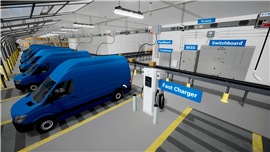 Among the solutions Eaton offers is the EV Charging Busway, designed to speed installation and deliver readily scalable charging capability. (Photo: Eaton)
Among the solutions Eaton offers is the EV Charging Busway, designed to speed installation and deliver readily scalable charging capability. (Photo: Eaton)
Yet, more than hardware is required. “Companies need strategies to enable existing energy systems to work harder and smarter to accelerate electrification. For example, load management software or adding DERs to their energy infrastructure helps eliminate choke points in their system to quickly deliver the additional power needed to electrify,” Cappeta explained.
Eaton sees enormous opportunity to manage energy more effectively by taking advantage of the “levers available through the energy transition.” According to Cappeta, this calls for breaking through the “traditional boundaries of what electrical systems can do.”
“We’re working with customers to optimize their energy systems so they can manage loads, avoid or defer capacity updates and incorporate renewables and energy storage to decarbonize electrification,” Cappeta stated. “For example, we’ve found a way to shrink charging technology down to the size of a circuit breaker, and we’re integrating it with our power distribution equipment for seamless installs that reduce installation time and increase reliability.” This integration also enables new flexibility, scalability and modularity, he added.
Eaton is helping to manage uptime, as well, through what Cappeta describes as the “largest services organization in North America” in order to execute on service-level agreements for fleet charging depots. In addition, the company is incorporating intelligence into its chargers and BESS via its Predict Pulse remote monitoring and management service.
“This technology actively monitors over 200 data points within hardware to predict and mitigate a potential failure before it happens. We can roll a truck with the right equipment and replace the soon-to-be defective part to prevent an unplanned outage,” Cappeta said. “Importantly, we also have fantastic channel partners across North America, who have stock locally to ensure availability of parts and support.”
These and other creative solutions will be essential to alleviating the pain points to adoption and assuring fleet owners and operators that they can successfully, and profitably, grow the number of commercial EVs in their fleets.
Helping users understand needs
“There is this de facto thought within the fleet markets that they need DC fast charging, which in the vast majority of cases is not actually correct,” said Atom Power’s Ryan Kennedy. Such Level 3 chargers pull substantially more energy from the grid and can be as much as 20x the cost to install compared to a Level 2 charging system.
“One of the things we have to do pretty consistently is to pull data to say: what are your driving habits, what kind of vehicles, what’s the dwell time,” Kennedy noted. “You find out that a substantial portion of fleet charging can be done with higher power Level 2 – like 19 kW.”
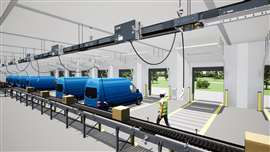
Eaton’s Joe Cappeta said the company has seen an over-simplification of charging demand modeling that results in some systems being overbuilt for their actual needs. “For example, people often want the largest charger, or they plan for the worst-case scenario – vehicles coming in on an empty battery and needing to get to 100% charge as quickly as possible,” he said. “Yet, typically, there’s a dwell time on these vehicles in excess of 10 hours. In that amount of time, you can deliver an enormous amount of power with just a 7.7-kW AC L2 charger, which would more than meet the needs of the vehicle.
“Understanding your charging needs is extremely important,” he said, adding that Eaton offers resources to help fleets future-proof and right-size charging, potentially saving both time and cost.Helping users understand needs
“There is this de facto thought within the fleet markets that they need DC fast charging, which in the vast majority of cases is not actually correct,” said Atom Power’s Ryan Kennedy. Such Level 3 chargers pull substantially more energy from the grid and can be as much as 20x the cost to install compared to a Level 2 charging system.
“One of the things we have to do pretty consistently is to pull data to say: what are your driving habits, what kind of vehicles, what’s the dwell time,” Kennedy noted. “You find out that a substantial portion of fleet charging can be done with higher power Level 2 – like 19 kW.”
Eaton’s Joe Cappeta said the company has seen an over-simplification of charging demand modeling that results in some systems being overbuilt for their actual needs. “For example, people often want the largest charger, or they plan for the worst-case scenario – vehicles coming in on an empty battery and needing to get to 100% charge as quickly as possible,” he said. “Yet, typically, there’s a dwell time on these vehicles in excess of 10 hours. In that amount of time, you can deliver an enormous amount of power with just a 7.7-kW AC L2 charger, which would more than meet the needs of the vehicle.
“Understanding your charging needs is extremely important,” he said, adding that Eaton offers resources to help fleets future-proof and right-size charging, potentially saving both time and cost.
POWER SOURCING GUIDE
The trusted reference and buyer’s guide for 83 years
The original “desktop search engine,” guiding nearly 10,000 users in more than 90 countries it is the primary reference for specifications and details on all the components that go into engine systems.
Visit Now
STAY CONNECTED




Receive the information you need when you need it through our world-leading magazines, newsletters and daily briefings.
CONNECT WITH THE TEAM










